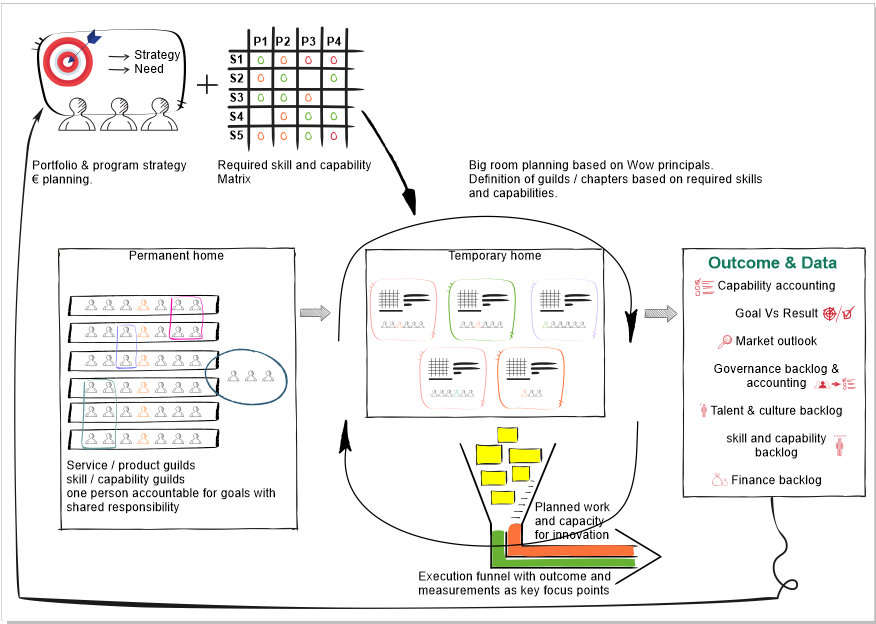KNOM Element One, where skills and capabilities are taught, acquired and iterated : Part 2


SAKET BIVALKAR
Business Coach
“In a world of commoditized knowledge, the returns go to the companies who can produce non-standard knowledge.”
– Gary Hamel
Or, as I would argue, superior returns go to the organisation that can share its non-standard knowledge interdependently and efficiently between its people within the organisation.

This article is part of a series on my brainchild: Knowledge Network Operating Model, or KNOM, what it is, and how the different elements interact and create synergistic adaptive effects. KNOM is founded on the principle that overperforming organisations adapt rather than shelter externalities, advocating for nimbleness rather than rigidity. But this article is specifically about Element One: Permanent Home.
Permanent Home derives its name from our associations of ‘home’ – It is where people in the KNOM organisation spend most of their time, finding respite, evaluating results, learning new skills, and taking on new capabilities: a home comprising of Guilds.
“Guilds” comes from its etymological origin in the Feudalistic era, of groups banded together in collaboration for the organisation, but also their professional, personal interests.
Each Guild is autonomous and categorised into accountability areas such as Product Guild, Legal Guild, Service Guild, et cetera. In a sense, the Permanent Home, and its Guilds, enable the constant iteration and adaptability central to the KNOM structure.
Dynamic reteaming.
The aspect distinguishing the first element: “Permanent Home”, is that it is the home base where skill sharing and capability learning take place. As we covered in the previous article, skills are immediate hard skills a person has, such as R-visualisations and coding, whereas capabilities are longer-term, more intellectual, such as strategic prowess.
These skills and capabilities are shared fluidly between and within each Guild, and can be explained with that:
Jane desires to relocate herself from the Product Guild to the Digital Service Guild based on the completion of a program in Temporary Home on ‘Digital Credit Cards’.
Jane found out through the required Skills & Capabilities Matrix that her data visualisation – R coding – was insufficient, but her go-to-market capability is solid. She decides to move to the Digital Service Guild in Permanent Home, where John resides, whose skillset is superior in R coding and data visualisation. Effectively John can teach Jane R coding, whereas Jane can teach go-to-market strategies to John.
Leadership & Motivation.
However, the crucial – invisible hand – directing the KNOM’s skills and capabilities through its programs is in Element 2: Strategy Formation & Program Development. Here executives and managers pitch and agree upon which programs, and subsequent, skills and capabilities to be shown in Element 3: Big Room Planning & Temporary Home.
This interplay between Element 1 to 3 designs and directs the organisation on the skills and capabilities needed, which then is freely chosen by each employee to acquire or teach in Permanent Home. Effectively, achieving the higher-order motivation self-actualisation from Maslow’s Pyramid of Needs, without direct managerial oversight.
Similarly, this is how each person grows within the KNOM framework as well, from the five stages of leadership agility: Expert to Synergist. Here is also where performance, appraisal and evaluation will be conducted: from performance in Temporary Home on the completion of Programs.
The Formation of Guilds.
In this context, the leadership and governance will be structured bottom-up from each Guild. As mentioned, every Guild has a leader in Strategy Formation & Program Development pitching and agreeing on programs and skills/capability matrixes for Temporary Home, i.e., each Guild Leader with upper management directs the organisation on a macro level.
Additionally, each Guild leader handles internal disputes and has the accountability to see smooth transitions of people between Guilds avoiding a vacuum of skills and capabilities per Guild. However, each Guild, when formed, develops a modus operandi, or live document, dictating the governance of said Guild. The onus here is that this document is malleable based on required changes. This similarly is connected with the type of Guild formed. For example, if we take a page from Team Topologies by Matthew Skelton and Manuel Pais, the kind of Guild will naturally define itself upon creation either as…
- concerned with a single feature or value stream, or
- holistic operations benefitting all other Guilds, or
- specialty tasks requiring the expertise from specialists, or lastly
- Business Intelligence & Analytics connected with externalities, aiding the other Guilds in identifying areas of needed transformation and change.
Independency & Autonomy.
Lastly, each Guild in Permanent Home operates independently, able to either collaborate and partner with the other Guilds, or externally with other businesses. This means that each Guild operates as its own enclave but shares the same pool of people within the structure of the KNOM organisation.
In short, the KNOM design by its skills and capabilities are continually iterated, diminished, or expanded upon based on the evaluated performance of temporary programs. But each Guild has a sense of community and personal growth, achieving a motivational drive to find value either externally outside of the organisation or internally in collaboration with another Guild.
In summary, Permanent Home and its comprising Guilds are a place where ‘non-standard knowledge’ not only is acquired and enabled but also shared and transferred based on the needs of the larger organisation and its environment. In essence, expanding on what Gary Hamel said, the KNOM organisation will produce non-standard knowledge adapted from external changes. While also continually ensuring that its people possess the right skills and practise the appropriate capabilities for continual and future growth.
In the next article, we will deep-dive into Element 2: Strategy Formation & Program Development.
Harnessing the Power of Management Innovation
Discover the transformative power of management innovation with Versatile Consulting in driving business success. Lets innovative management practices that can create a competitive edge, foster a culture of innovation, and navigate the challenges of today’s dynamic business environment.
Understanding Organisational Culture: Symptoms and Impact.
Organizational culture is a complex and multifaceted concept that influences the behavior of individuals within an organization. By understanding the different interpretations of culture and the symptoms of different types of organizational cultures, organizations can take steps to create a positive and healthy work environment that fosters collaboration, innovation, and growth.
KNOM Element Five, data through intuition and intuition through data: Part 6
The final part of the article series on KNOM Element Five discusses how consistent change can be instigated through knowledge. Element Five: Outcome & Data Insights is the lifeblood of the KNOM organization, aggregating and dissecting data into actionable insights. To avoid having data smelling like rubbish, the article suggests establishing beforehand the aims the data must generate insights towards and help to improve. The article explains the data pyramid and how data is a tool for enhancing intuition. Element Five: Outcome & Data Insights proceeds through all the levels of the pyramid in different categories. These six categories are the most commonly utilized: Capability Accounting, Goals Vs Results, Market Outlook & Changes, Governance Backlog & Accounting, Talent & Culture Backlog, and Finance Backlog.



